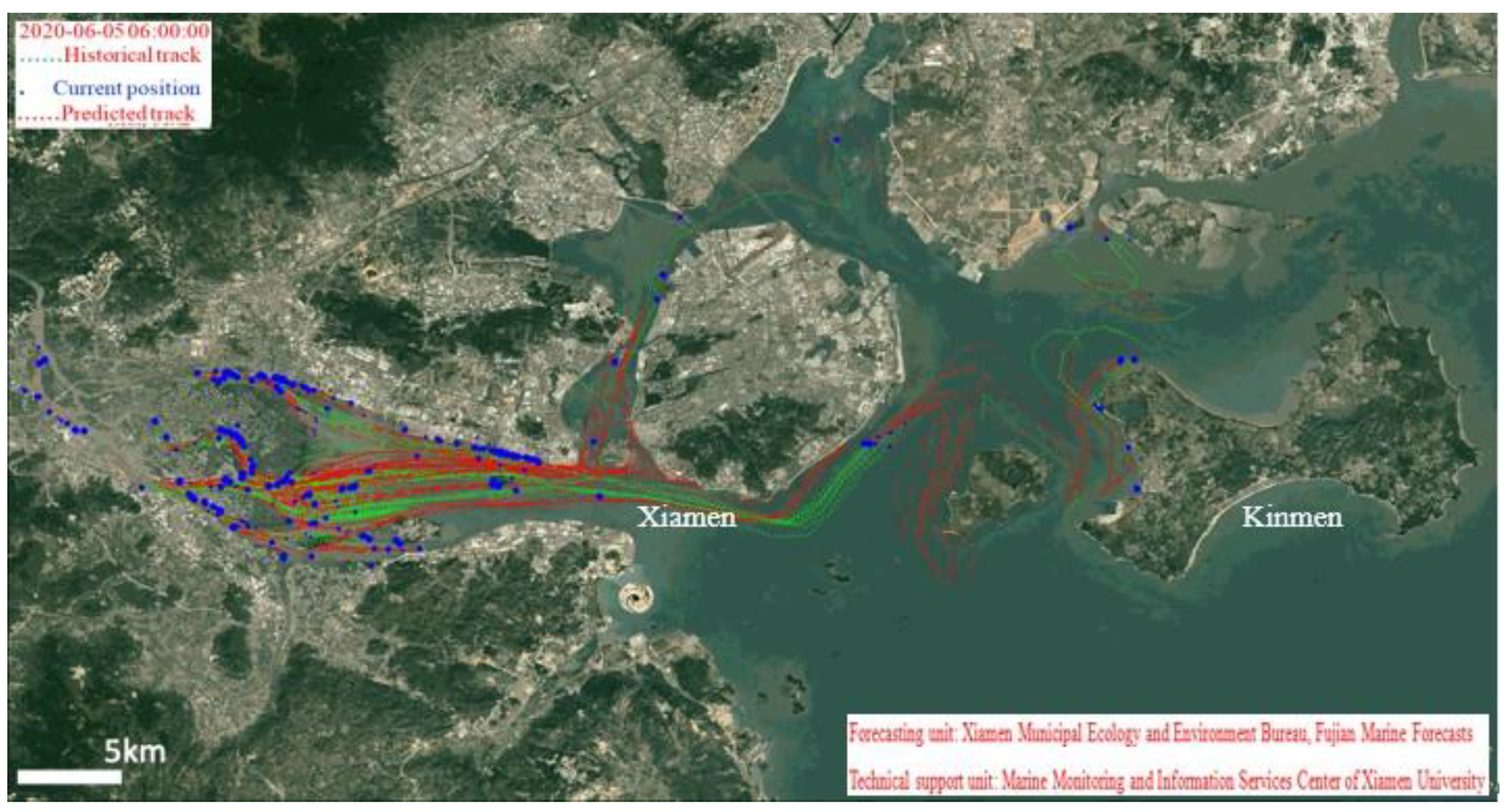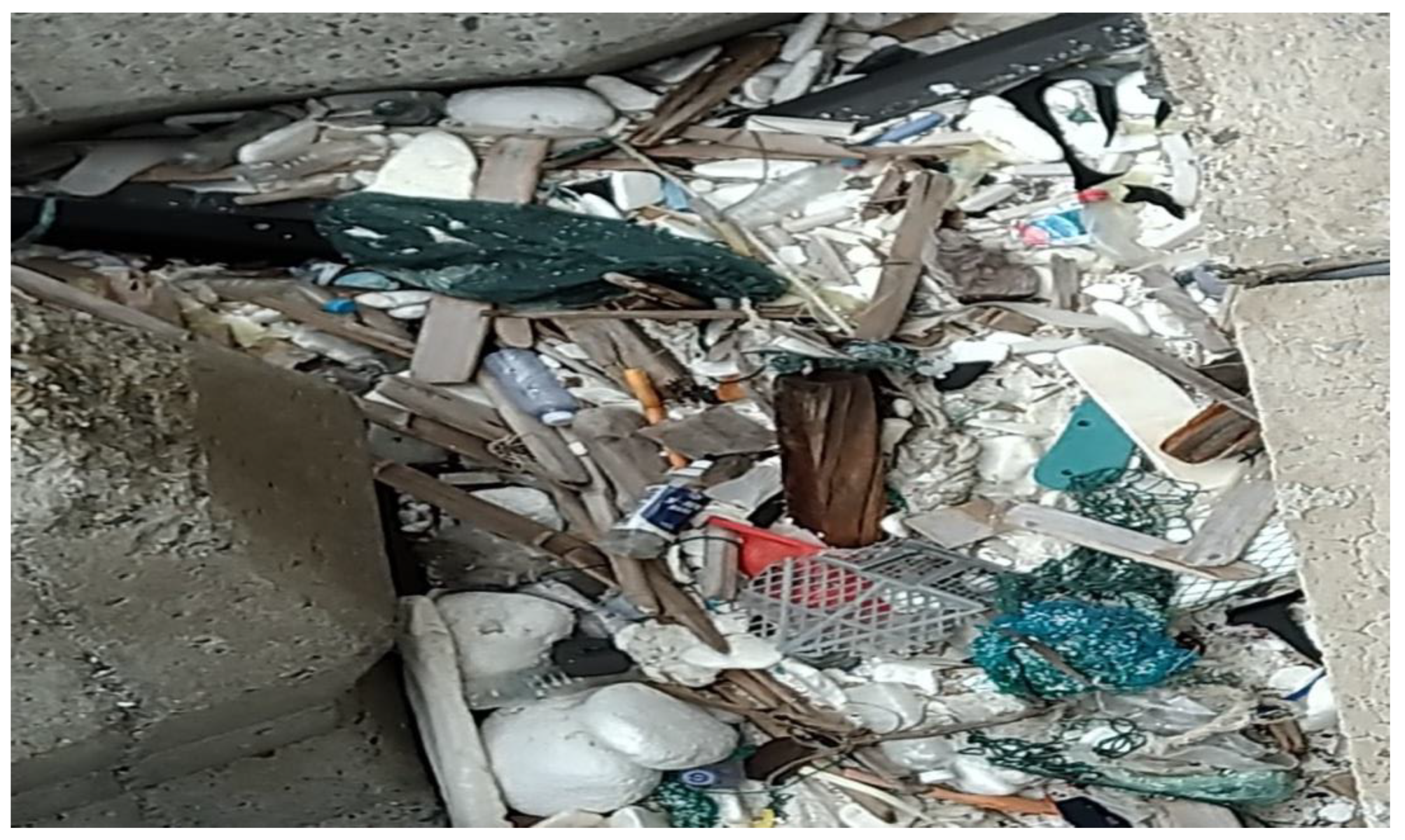A Study on Transboundary Marine Governance of Floating Marine Debris—Taking Kinmen–Xiamen Waters between China and Taiwan as an Example
Abstract
:1. Introduction
2. Literature Review
2.1. Floating Marine Debris
2.2. Correlation between Floating Marine Debris in Kinmen and Xiamen
2.3. Transboundary Marine Governance between Kinmen and Xiamen
3. Method
3.1. General Situation of Floating Marine Debris in the Study Area
3.2. Methods
4. Analysis and Discussion
4.1. Analysis of the Current Situation of Floating Marine Debris in Kinmen and Actions Taken by the Governments
4.2. Results Analysis of Field Surveys, Expert Opinion Surveys and In-depth Interviews
4.2.1. Field Surveys
4.2.2. Expert Opinion
4.2.3. Results Analysis of In-Depth Interviews
4.3. Analysis of Transboundary Marine Governance in Kinmen–Xiamen Waters
4.3.1. Possible Dilemma
4.3.2. Necessity and Feasibility Analysis of Transboundary Governance of Floating Marine Debris in Kinmen–Xiamen Waters
5. Conclusions and Recommendations
5.1. Research Conclusions
5.2. Recommendations for Future Research
5.2.1. Comprehensive Recommendations for Remediation of Floating Marine Debris
5.2.2. Recommendations for Transboundary Marine Governance
Author Contributions
Funding
Institutional Review Board Statement
Informed Consent Statement
Data Availability Statement
Conflicts of Interest
References
- Purba, N.P.; Faizal, I.; Cordova, M.R.; Abimanyu, A.; Afandi, N.K.; Indriawan, D.; Khan, A. Marine debris pathway across Indonesian boundary seas. J. Ecol. Eng. 2021, 22, 82–98. [Google Scholar] [CrossRef]
- Beaumont, N.J.; Aanesen, M.; Austen, M.C.; Börger, T.; Clark, J.R.; Cole, M.; Wyles, K.J. Global ecological, social and economic impacts of marine plastic. Mar. Pollut. Bull. 2019, 142, 189–195. [Google Scholar] [CrossRef]
- Liu, G.Y.; Ho, R.H.; Chen, N. Taiwan’s outlying islands become China’s garbage dump. Common Wealth Mag. 2014, 551, 6. (In Chinese) [Google Scholar]
- Lin, T.H. Current Status and Disposal Policy of Marine Debris in Kinmen and Xiamen Sea Areas. Master’s Thesis, Institute of Marine Affairs, National Sun Yat-Sen University, Kaohsiung, Taiwan, 2019. (In Chinese). [Google Scholar]
- Pasternak, G.; Ribic, C.A.; Spanier, E.; Ariel, A.; Mayzel, B.; Ohayon, S.; Zviely, D. Nearshore survey and cleanup of benthic marine debris using citizen science divers along the Mediterranean coast of Israel. Ocean Coast. Manag. 2019, 175, 17–32. [Google Scholar] [CrossRef]
- Chen, C.L.; Kuo, P.H.; Lee, T.C.; Liu, C.H. Snow lines on shorelines: Solving Styrofoam buoy marine debris from oyster culture in Taiwan. Ocean Coast. Manag. 2018, 165, 346–355. [Google Scholar] [CrossRef]
- Islam, M.S.; Hui Pei, Y.; Mangharam, S. Trans-boundary haze pollution in Southeast Asia: Sustainability through plural environmental governance. Sustainability 2016, 8, 499. [Google Scholar] [CrossRef] [Green Version]
- Seltenrich, N. New link in the food chain? Marine plastic pollution and seafood safety. Environ. Health Perspect. 2015, 123, 34–41. [Google Scholar] [CrossRef] [Green Version]
- Jambeck, J.R.; Geyer, R.; Wilcox, C.; Siegler, T.R.; Perryman, M.; Andrady, A.; Law, K.L. Plastic waste inputs from land into the ocean. Science 2015, 347, 768–771. [Google Scholar] [CrossRef] [PubMed]
- Van Sebille, E.; Aliani, S.; Law, K.L.; Maximenko, N.; Alsina, J.M.; Bagaev, A.; Wichmann, D. The physical oceanography of the transport of floating marine debris. Environ. Res. Lett. 2020, 15, 023003. [Google Scholar] [CrossRef] [Green Version]
- Chen, H.; Wang, S.; Guo, H.; Lin, H.; Zhang, Y.; Long, Z.; Huang, H. Study of marine debris around a tourist city in East China: Implication for waste management. Sci. Total Environ. 2019, 676, 278–289. [Google Scholar] [CrossRef]
- Ghaffari, S.; Bakhtiari, A.R.; Ghasempouri, S.M.; Nasrolahi, A. The influence of human activity and morphological characteristics of beaches on plastic debris distribution along the Caspian Sea as a closed water body. Environ. Sci. Pollut. Res. 2019, 26, 25712–25724. [Google Scholar] [CrossRef]
- Lee, H. A Study of Waste Disposal Problem and Policy between Kinmen and Xiamen. Master’s Thesis, Institute of Mainland China Studies, National Quemoy University, Kinmen, Taiwan, 2010. [Google Scholar]
- Lin, T.H.; Kao, R.H.; Chang, S.K. Existing situation of remediation of floating marine debris in Kinmen County and analysis of policy recommendations. In Proceedings of the 2nd Kinmen-Xiamen Area Collaborative Development and Exchange Symposium, Xiamen, China, 2017. [Google Scholar]
- Wang, Y.H. Research Report on Ocean Current Survey and Coastal Debris Removal Planning in Kinmen County; Fisheries Research Institute: Kinmen, Taiwan, 2016. (In Chinese) [Google Scholar]
- Lee, W.L. Investigation and countermeasures of floating waste pollution in Xiamen-Jinmen sea area. Environ. Sanit. Eng. 2009, 17, 46–51. (In Chinese) [Google Scholar]
- Chen, C.C.; Fang, Q.; Hsieh, H.S.; Zhuang, S.J.; Chen, J.Y.; Chang, S.S. Feasibility Analysis of Environmental Coordinated Management of Kinmen-Xiamen Waters. Ocean Dev. Manag. 2004, 21, 24–29. [Google Scholar]
- Chen, X.C.; Wang, W.Q. A study on eco-environmental security cooperation on waters between Xiamen and Kinmen. Ecol. Environ. 2013, 275, 178–181. [Google Scholar]
- Lee, W.L. Management and countermeasures of floating waste pollution in Xiamen Sea Area. Guangzhou Chem. Ind. 2014, 20, 154–156. (In Chinese) [Google Scholar]
- Dai, H.; Yang, B.C.; Yan, L.L.; Zhang, Y.; Yuan, C.W. Treatment suggestions on drifting waste in Xiamen sea area. Ocean Dev. Manag. 2018, 11, 67–71. (In Chinese) [Google Scholar]
- Choksi, S. The Basel Convention on the control of transboundary movements of hazardous wastes and their disposal: 1999 Protocol on Liability and Compensation. Ecol. LQ 2001, 28, 509. [Google Scholar]
- Ogunseitan, O.A. The Basel Convention and e-waste: Translation of scientific uncertainty to protective policy. Lancet Glob. Health 2013, 1, 313–314. [Google Scholar] [CrossRef] [Green Version]
- Zhao, F. The 13th Five-Year Plan for Environmental Protection of Xiamen Municipality Has Been Released (with Key Projects). China Daqi Website. 2017. Available online: http://www.chndaqi.com/news/view?id=253455&page=13 (accessed on 26 March 2021).
- Chien, S.S.; Hong, D.L. River leaders in China: Party-state hierarchy and transboundary governance. Political Geogr. 2018, 62, 58–67. [Google Scholar] [CrossRef]
- Jay, S.; Alves, F.L.; O’Mahony, C.; Gomez, M.; Rooney, A.; de Vivero, J.L.S.; Almodovar, M.; Goncalves, J.; Gee, K.; Fernandes, M.L.; et al. Transboundary dimensions of marine spatial planning: Fostering inter-jurisdictional relations and governance. Mar. Policy 2016, 65, 85–96. [Google Scholar] [CrossRef]
- Lo, C.C.; Liu, H.; Geng, X. Cross-Boundary Governance Research of Coastal Rivers in Taiwan: Case Study of the Nanshih River Basin. J. Coast. Res. 2020, 109, 210–215. [Google Scholar] [CrossRef]
- Wang, Q.L.; Lee, Y.F. Integrated Land-Marine Management for the Eco-environmental Development in the New Era of Xiamen, China. Chin. J. Environ. Manag. 2018, 10, 87–91. (In Chinese) [Google Scholar]
- Zhuang, H.N. The First Self-Propelled ATV Beach Cleaner in the Country Kinmen Daily News. 2013. Available online: http://web.kinmen.gov.tw/Layout/main_ch/News_NewsContent.aspx? (accessed on 21 December 2020).
- Jin, Y.H.; Kao, R.H. Analysis on the necessity and feasibility of across boundary governance of floating marine debris in Kinmen and Xiamen sea area. In Proceedings of the 2021 Marine Affairs and Marine conservation in Kinmen Conservation Academic Seminar, Kinmen, Taiwan, 2021. [Google Scholar]
- Ma, H.Y.; Kao, J.C.; Kao, R.H. How to establish a sustainable sea area governance mechanism? The case of marine waste. Int. J. Sustain. Dev. World Ecol. 2021. [Google Scholar] [CrossRef]
- Emerson, K.; Gerlak, A.K. Adaptation in collaborative governance regimes. Environ. Manag. 2014, 54, 768–781. [Google Scholar] [CrossRef] [PubMed]
- Kern, K.; Söderström, S. The ecosystem approach to management in the Baltic Sea Region: Analyzing regional environmental governance from a spatial perspective. Mar. Policy 2018, 98, 271–277. [Google Scholar] [CrossRef]
- Emerson, K.; Nabatchi, T.; O’Leary, R. Environmental Collaboration and conflict resolution. In Environmental Governance Reconsidered; MIT Press: Cambridge, MA, USA, 2017; pp. 263–296. [Google Scholar]
- Gartry, L. Seabin’ Designed by Australian Surfers to Clean Up Marinas, Reduce Ocean Pollution. ABC NEWS. Available online: http://www.abc.net.au/news/2015–12–20/seabin–designed–by–australian–surfers–to–start–cleaning–up–ocean/7044174 (accessed on 13 December 2020).
- Seabin Project. Seabin Project: About Us. Seabin Project. Available online: http://seabinproject.com/about–us/ (accessed on 26 March 2021).
- Kao, R.H.; Cho, C.C.; Lin, T.H.; Kim, Y.H. A study on the concept of spatial planning in Kinmen and Xiamen sea area from the marine environmental deterioration and maritime safety– The case of trespassed fishing, illegal sea sand mining and floating waste. Marit. Q. 2019, 28, 79–110. (In Chinese) [Google Scholar]






| Year | Recyclable (ton) | Non-Recyclable (ton) | Total (ton) |
|---|---|---|---|
| 2011 | 60.91 | 293.98 | 354.89 |
| 2012 | 33.63 | 443.99 | 477.62 |
| 2013 | 43.78 | 556.03 | 599.81 |
| 2014 | 27.64 | 517.14 | 544.78 |
| 2015 | 41.81 | 412.76 | 454.57 |
| 2016 | 34.08 | 367.52 | 401.60 |
| 2018 | 45.512 | 389.589 | 435.101 |
| 2019 | 41.208 | 535.318 | 576.526 |
| 2020 | 64.966 | 390.818 | 455.784 |
| Total | 393.536 | 3907.145 | 4300.681 |
| Average | 43.726 | 434.127 | 477.853 |
| Ranking | Type | Weight (ton) | % |
|---|---|---|---|
| 1 | Other waste | 639.88 | 55.40% |
| 2 | Bamboo and wood | 384.86 | 33.32% |
| 3 | Styrofoam | 73.47 | 6.36% |
| 4 | Fish nets and equipment | 15.1 | 1.38% |
| 5 | PET bottle | 13.20 | 1.14% |
| 6 | Glass bottle | 11.74 | 1.01% |
| 7 | Tin can | 10.95 | 0.9% |
| 8 | Aluminum can | 5.25 | 0.45% |
| 9 | Waste paper | 0.43 | 0.04% |
| Total | 1154.88 | 100% | |
Publisher’s Note: MDPI stays neutral with regard to jurisdictional claims in published maps and institutional affiliations. |
© 2021 by the authors. Licensee MDPI, Basel, Switzerland. This article is an open access article distributed under the terms and conditions of the Creative Commons Attribution (CC BY) license (https://creativecommons.org/licenses/by/4.0/).
Share and Cite
Kao, J.-C.; Cho, C.-C.; Kao, R.-H. A Study on Transboundary Marine Governance of Floating Marine Debris—Taking Kinmen–Xiamen Waters between China and Taiwan as an Example. Sustainability 2021, 13, 14063. https://doi.org/10.3390/su132414063
Kao J-C, Cho C-C, Kao R-H. A Study on Transboundary Marine Governance of Floating Marine Debris—Taking Kinmen–Xiamen Waters between China and Taiwan as an Example. Sustainability. 2021; 13(24):14063. https://doi.org/10.3390/su132414063
Chicago/Turabian StyleKao, Jui-Chung, Cheng-Chung Cho, and Rui-Hsin Kao. 2021. "A Study on Transboundary Marine Governance of Floating Marine Debris—Taking Kinmen–Xiamen Waters between China and Taiwan as an Example" Sustainability 13, no. 24: 14063. https://doi.org/10.3390/su132414063






